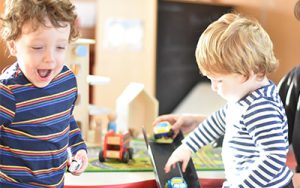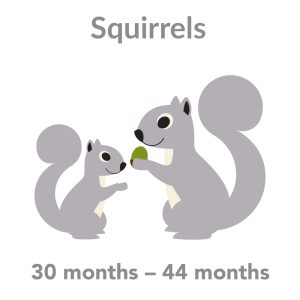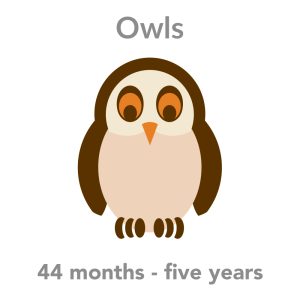Bunnies
3 months – 18 months
We can accommodate up to 14 children between three months and 18 months in our baby section, known as Bunnies. There is also a separate room that contains cots for sleeping. The staffing ratio is 1:3.

Bunnies Two
18 months – 30 months
We can accommodate up to 14 children aged between 18 months and 30 months.
In Bunnies Two, the children will start to develop their independence and build friendships.
There is a mixed ratio in this room. Under twos have a ratio of 1:3 and those aged two and over have a 1:5 ratio. At around 30 months they will move up to our Squirrels room.


Staff plan care using The Highwood Curriculum, which enables babies to explore a variety of different sensory experiences including musical instruments, sand, water and other malleable play. They may also participate in various art activities, outdoor play and story time sessions. The roleplay area and a selection of books and toys are accessible at all times. All toys are cleaned regularly to maintain good hygiene standards and prevent cross-infection.

All feeding matters will be discussed with you at your child’s first settling session. We recommend that young babies should be able to accept a cup or bottle prior to starting. This will aid settling and help maintain their feeding routine. Mothers who wish to come in and breastfeed will be offered a quiet area to do so. Weaning may only be started following a full discussion with you.
All dietary requirements will be observed strictly. Babies will be fed on demand and, where possible, by the same carer until they are ready to follow the routine of the group.
We encourage young babies to sleep on their backs, feet to foot, in cots in our quiet and relaxing sleep room, where a comfortable temperature is maintained.
All babies will be changed when needed. Strict nappy changing procedures are followed to ensure good hygiene. Nappies, cream, wipes, talc, and anything else needed, should be provided by you in order to maintain a reasonable stock in your child’s individual cubby hole.
 The babies move into the Squirrels group when they are around 30 months. They will start the settling process about a month before they move up, provided they are developmentally ready. You will be informed of settling sessions and your child’s new Key Carer by letter or email. Staff support this transition by ensuring children in the next group are aware of newcomers’ specific likes and dislikes, for example.
The babies move into the Squirrels group when they are around 30 months. They will start the settling process about a month before they move up, provided they are developmentally ready. You will be informed of settling sessions and your child’s new Key Carer by letter or email. Staff support this transition by ensuring children in the next group are aware of newcomers’ specific likes and dislikes, for example.



